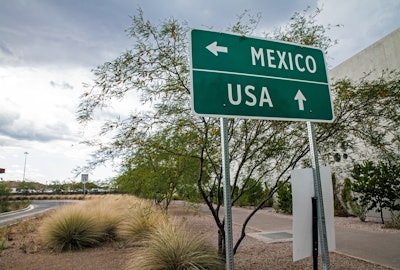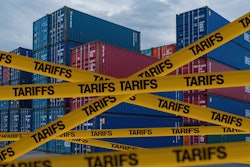
In the U.S. Census Bureau’s July 2025 report on top trading partners, Mexico reigns as the unprecedented leader for imported goods, coming in nearly four percentage points higher than Canada, the next leading source of products for American consumers and supplies for businesses.
Furthermore Mexico’s momentum as the United States’ top trading partner is increasing, with the U.S. Census Bureau and the U.S. Bureau of Economic Analysis announcing on Sept. 4 that Mexico’s total imports into the United States from January-July of this year amounted to $309.75 billion, representing a 6.5% year-over-year increase. And perhaps most notably, under the provisions of the United State-Mexico-Canada Agreement (USMCA), compliant goods continue to arrive duty free.
With such robust trade volumes, it comes as no surprise that American companies continue to see Mexico as a particularly attractive haven for nearshoring. But unlike years past in which Mexico was largely viewed as a cost-saving alternative to domestic production and global sourcing practices, the attraction for many American businesses today reflects the desire to streamline supply chains, and just as importantly, mitigate risks.
In the push to secure savings and mitigate risks, Mexico offers many additional benefits as a nearshoring destination, among them:
● Geographic proximity: While Mexico’s shared border is an obvious differentiator when shortening supply chains from Asia, the geographic advantages are extensive. Mexico has proximity to Central and South America and a strong port system easily accessible via Atlantic and Pacific trade routes. Business operations are also naturally streamlined, with North American time zones making the work with Mexico feel familiar to American executives. Shorter distances also equate to lower inventory levels, a benefit that frees up capital.
● Preferred trading status: USMCA is a significant differentiator that plays an important role in making Mexico the nearshoring home for many American blue-chip companies and household names. As previously mentioned, USMCA compliant goods are tariff free, one of the reasons that Mexico is of interest for manufacturers in the automotive industry.
● A large and accessible market for labor: Manufacturing centers like Monterrey boast an extensive workforce, with labor rates for manual industrial and manufacturing tasks being significantly lower than comparative positions in the United States. An equally robust skilled labor force is also available at rates comparable to those in the United States.
● Cultural alignment: Language differences aside, there is significant cultural alignment between American and Mexican business practices. Travel and recreation across the border and between both countries is commonplace, a factor that makes business interactions feel equally familiar.
● Sophisticated manufacturing centers and capabilities: Mexico’s manufacturing centers are home to sophisticated and highly advanced manufacturing facilities. For example, growth is occurring in the aerospace and medical device sectors, where stringent tolerances and demanding quality standards are expected. As a result, leading brands from various regions are seeking to establish a closer presence to American markets and consumers. Just as importantly, there is a thriving services community that provides the maintenance, repair, supply, and support expertise all industrial operations require.
All of these issues have helped to make Mexico the leading nearshoring destination for companies that want to control costs, shorten supply chains, and make their goods in a manufacturing-friendly environment. But while nearshoring efforts are expected to continue to increase, there are significant challenges businesses considering Mexico should keep in mind.
Every rose has its thorns
Success in nearshoring is anything but guaranteed. Businesses should be prepared to address challenges commonly encountered in Mexico:
● Competition for labor is fierce: While there is a large base of manual and skilled labor in Mexico’s industrial centers, retaining employees can be challenging. Competition for available talent is also increasing as companies from around the globe vie for workers.
● Space is limited: In many areas, available space is now in high demand. Many organizations find it particularly difficult to find space for greenfield development.
● Infrastructure can be unreliable: Power is expensive in Mexico, and the electrical grid in many areas is prone to outages. Water resources are also limited in many areas, making the creation of some items problematic.
● Safety is still a concern: While major manufacturing and industrial areas are relatively safe, crime – particularly around drug trafficking operations – remains an issue. In some areas, security-related costs must be considered an operational necessity.
Plan to ensure success
Fortunately, there are steps companies can take to ensure that their nearshoring strategy in Mexico is successful. Some of the core steps every organization should consider include:
● Conduct a thorough cost-benefit analysis: The detailed business case that should accompany any consideration of nearshoring should include a robust cost-benefit analysis. Risks should also be weighed and included. For example, the cost of expediting a trans-Atlantic shipment for supplies should be factored in when comparing suppliers and operations in Mexico with those in Asia. Ideally, these assessments should be done with a third-party that possesses extensive expertise of nearshoring in Mexico.
● Complete a thorough site-selection process: Companies must determine at the outset if they are simply looking to nearshore suppliers or desire to build their own facilities in Mexico. Labor, power, water resources, and available space – both greenfield and brownfield – must all be considered, vetted, and inspected in advance.
● Invest in employees and partners: Employees in Mexico are often accustomed to, and expect, to work with companies that treat them as true partners with a “family feel” that often includes the employer providing daily lunches, transportation to and from work, and other benefits. In a highly competitive market for talent, such practices are increasingly required as a matter of course.
● Partner with a local services company: Companies considering the nearshoring of their suppliers, or the construction of their own facilities, should consider partnering with a local services firm that is familiar with local regulations and compliance requirements. Local equipment and service providers should also be considered when looking for partners. Mutually beneficial, genuine, and long-lasting business relationships are highly valued in Mexico. Their value cannot be overstated.
● Remember, it’s still not the United States: While nearshoring in Mexico may be easier than working with suppliers or contract manufacturers in Asia from a logistics standpoint, it is still not the United States. Cross-border shipments, for example, still have a potential to be delayed, which needs to have contingencies planned for.
Many businesses make the mistake of viewing nearshoring as a short-term solution for market dynamics or fail to fully take into account the sheer scale of planning and preparation required to ensure success. Nearshoring in Mexico cannot be viewed through a lens that merely considers costs and transactions. Instead, it must be approached as a long-term investment that seeks to minimize risks.
Nearshoring in Mexico is an attractive option for many companies that want to revitalize their supplier networks, shorten their supply chain, and mitigate risks in their manufacturing operations. By carefully considering the many benefits Mexico offers, contemplating the limitations and challenges that sometimes arise, and implementing proven strategies to ensure their preparedness, U.S. companies can explore and approach their nearshoring aspirations with confidence.




















